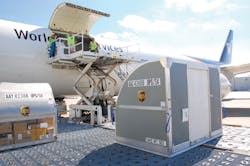UPS Begins Using Fire-Resistant Cargo Containers
UPS Airlines placed an industry-first order for more than 1,800 new fire-resistant cargo containers capable of containing intense fires for four hours, and announced other fire-safety initiatives following a report that linked the fatal crash of one of the company’s 747s to a shipment of lithium batteries that caught fire.
“These containers are a game changer, both for UPS and the industry as a whole,” said UPS Chief Operating Officer David Abney. “They represent a quantum leap forward in safety, an area where UPS places the highest emphasis.”
The MACROLite containers, built by Macro Industries, Huntsville, AL, are made from a fiber-reinforced plastic composite.
Burn testing conducted by UPS and the Federal Aviation Administration, and observed by the National Transportation Safety Board, has shown that a ULD with MACROLite panels can contain a fire with a peak temperature of 1,200 degrees F for more than four hours.
“That timeframe would give a flight crew ample time to land safely in the event of an in-flight fire,” the airline says in a press release.
DUBAI CRASH
Time was a crucial factor for the crew aboard UPS Flight 6 as it left Dubai International Airport on Sept. 3, 2011 en route to Cologne Bonn Airport. The crew reported smoke in the cockpit just 20 minutes after takeoff and was returning to Dubai.
As more smoke filled the cockpit and equipment failed, the plane was too high on its initial approach. The plane was turning back for another approach when in crashed near a military base, killing Captain Doug Lampe and First Officer Matthew Bell.
UPS made the ULD announcement one day before the United Arab Emirates’ General Civil Aviation Authority released a 322-page final incident report that confirmed a shipment of lithium batteries caught fire and caused the crash.
According to the report, the GCAA found “with reasonable certainty” that the fire originated from “an element” of the cargo that contained, among other items, lithium batteries.
The authority worked with UPS, Boeing, the National Transportation Safety Board and the Federal Aviation Administration in its three-year investigation.
“It is possible that a lithium-type battery or batteries, for reasons which cannot be established, went into an energetic failure characterized by thermal runaway and auto ignited, starting a chain reaction which spread to the available combustible material,” said the GCAA report.
NEW ULDS
Delivery of the new ULDs for UPS will begin this month is expected to be completed by early 2014.
About 75 test containers have already been evaluated on more than 5,600 trips during an eight-month period.
“We have tested these containers in the laboratory and in live operations,” said UPS Airlines President Mitch Nichols. “They will enhance safety and increase durability, and they are lighter, which will reduce fuel burn and supports our ongoing sustainability efforts.”
The new containers are the latest in a series of fire safety enhancements recommended by a joint safety task force run by UPS and the Independent Pilots Association, the union that represents UPS’ pilots.
“As UPS pilots, we are determined to do everything in our power to minimize the risk associated with on-board smoke and fire events,” said IPA president Robert Travis. “This includes proper regulations governing the carriage of hazardous materials [such as] lithium batteries.”
Other measures include the following:
- Fire-containment covers for cargo pallets: UPS purchased 575 of the covers, which can contain a 1,200-degree fire for four hours.
- Quick, donning full-face oxygen masks: UPS has already installed these masks, which can be easily put on with one hand in three seconds on 747s and MD-11s. That mask will be installed throughout its fleet my next year.
- Emergency Vision Assurance System (EVAS): UPS has completed installation of this inflatable cockpit vision system on our 747-400 fleet. The system enables pilots to see their instruments and out of the front window when smoke is present.
Other ongoing efforts to enhance fire safety include the following:
- Enhanced training for fire-related emergencies, as well as enhanced customer and employee training on hazardous material shipping.
- FAA certification for an in-container fire suppression system.
- Advocating for harmonization of domestic and international shipping regulations.
- Research and testing of fire-resistant collapsible containers.
